Denise Sutherland's Blog, page 6
May 28, 2013
Crosswords in other languages
The crossword was invented nearly exactly 100 years ago — yes, 2103 is its centenary! We all know that in that time it's spread throughout all English-speaking countries.
But what about other countries? The answer is a resounding yes!
In almost every country that I researched, they have crosswords. The forms are often a bit different from what we're used to — the grids are often non-symmetrical, 2-letter words are allowed, accented characters are often ignored, and sometimes the clues are written into the black squares.
Here are some links to crossword sites from other countries, for your enjoyment.
Afrikaans blokkieraaisel
 Part of a Chinese crossword
Part of a Chinese crosswordChinese 填字游戏
Danish kryds og tværs
Dutch kruiswoordraadsel
 Finnish crosswords often include picture clues
Finnish crosswords often include picture cluesFinnish Sanaristikko
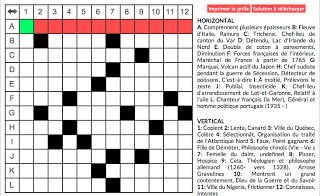 French grids use a different numbering system
French grids use a different numbering systemFrench mots croises
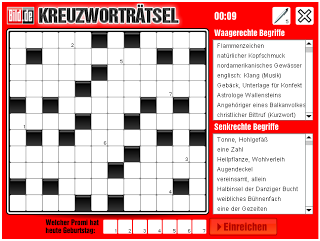 A German crosswordGerman Kreuzworträtsel
A German crosswordGerman KreuzworträtselGreek σταυρόλεξο
 Part of a Hebrew crossword
Part of a Hebrew crosswordHebrew תשבץ
Indonesian teka-teki silang
 Italian crosswords use rectangles rather than squaresItalian cruciverba
Italian crosswords use rectangles rather than squaresItalian cruciverba Japanese クロスワード パズル
 A bit of a Korean crossword
A bit of a Korean crosswordKorean 크로스 워드 퍼즐
 A Polish crosswordPolish Krzyżówka
A Polish crosswordPolish KrzyżówkaRomanian cuvinte încrucişate
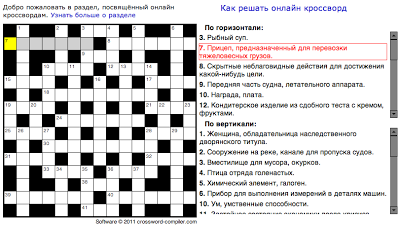 The Russian grids seem to be the only non-English ones that are symmetricalRussian кроссворд
The Russian grids seem to be the only non-English ones that are symmetricalRussian кроссворд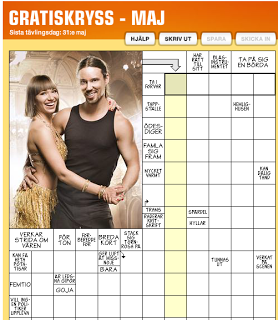 Part of a Swedish crosswordSwedish Korsord
Part of a Swedish crosswordSwedish KorsordSpanish crucigramas
Turkish Kare Bulmaca
As for cryptic crosswords, as far as I can tell, they are very much a British English phenomenon. I think that some countries may have puns or plays on words in some clues, but I don't think there is anything that really approaches the full complexity of a cryptic.
Published on May 28, 2013 21:25
May 23, 2013
Lesson 11: Cryptic Definitions and &lit
There are a bunch of other sorts of cryptic clues, which don't really adhere to any of the rules we've covered so far (damn it!).
These are the cryptic definition and &lit clues.
Cryptic definition clues
These clues are sort of puns, or cryptic definitions for a word. They are sometimes called 'single definition' clues. They don't really have any wordplay, and as such can be quite tricky and hard to solve. These will often be the last clues you fill in, in a crossword, after you've got quite a few hints from the crossing over letters! These sorts of clues are also often indicated with an exclamation mark.
Some examples:
A wicked thing! = CANDLE (it has a wick)
HIJKLMNO = WATER (H to O, or H2O)
The ringmaster = JEWELLER (he's the master of rings, clearly)
Sleep soundly = SNORE (sleep while making a sound)
So, you can see that these clues don't have the classic definition + wordplay form, but are more funny plays on words, tricky interpretations of the answers, that you have to 'read the right way' to get. Coined words are often used, like a BUTTER = RAM (a thing that butts).
Here are a few cryptic definition clues to try for yourself:
1) An Italian flower (3)
2) Playtime! (5)
3) A stiff examination? (4-6)
&lit clues
These are a much rarer type of cryptic clue. The words that can be clued this way are limited, and they are extremely hard to write well, so you won't come across them often. But it's good to know what they are!
&lit means "and literally". They are sometimes called 'double duty' clues, because every word in the clue does 'double duty', being read and interpreted twice.
As DS Macnutt (Ximenes) says in Ximenes on the Art of the Crossword :
"The term "&lit" is short for "This clue both indicates the letters or parts of the required word, in one of the ways already explained in this book, and can also be read, in toto, literally, as an indication of the meaning of the whole word, whether as a straight or as a veiled definition." (pg 73)These are clues where the surface reading of the clue actually means something (for a change!). You need to read and analyse the clue twice — first you read the whole clue as a piece of wordplay, and then you read the clue a second time literally — the surface meaning of the clue provides the definition for the answer. Both readings — wordplay and definition — give the same answer. These clues are sometimes (but not always) indicated with an exclamation point.
Here's an example:
Terribly angered! (7) = ENRAGED
So, the wordplay here is terribly angered — terribly is an anagram indicator, and angered is the anagram fodder. ENRAGED is an anagram of ANGERED. But wait - this is just the wordplay, without a definition, isn't it? No! The whole clue reads as the definition ... terribly angered is a perfectly reasonable definition for ENRAGED.
This is when models that have lost their shape are employed (6) = SELDOM
The wordplay is an anagram (lost their shape) of models. The whole clue reads as an oblique definition for SELDOM too.
Other sorts of wordplay can be used, of course, not just anagrams.
See if you can get these examples out (but don't feel badly if they defeat you!):
4) All you'll get out of a misbegotten nuisance (5)
5) No fellow for mixing (4,4)
 Petal looks a little startled by these clues!
Petal looks a little startled by these clues!Hints
1) A flower can be a thing that flows, like a river.
2) Play some music, at what sort of a time, or beat?
3) A stiff can be a dead body ...
4) This is a hidden word &lit clue. The answer is actually there to see 'in the clear' within the words of the clue. Seek and ye shall find!
5) Mixing is an anagram indicator, no fellow is the fodder. Remember, the whole clue, read literally, is the definition here!
Answers
1) TIBER
2) TEMPO
3) POST-MORTEM
4) ENNUI
5) LONE WOLF
How did you get on?
Published on May 23, 2013 18:14
April 17, 2013
Déesse Cryptics
I've got a special treat for you today, two whole cryptic crosswords by me, for you to download. These are PDF files, which you can print out. The answers are included, too.
Déesse Cryptic #1 Déesse Cryptic #2
Griff is tucked up in bed, and doesn't seem that impressed — but hopefully you will enjoy them!

Déesse is my 'cryptic' name: it's how my initials sound when you say them aloud (DS = 'Dee Ess'), and it happens to mean goddess in French ;)
Published on April 17, 2013 19:05
April 16, 2013
Lesson 10: Homophones
Homophone cryptic clues are rather fun. But first, let's figure out what a homophone is.
Homo means 'same', and phone means 'sound' — so homophones are words which sound alike, but have different meanings.
I'm sure you know a ton of these: ATE & EIGHT. FLOUR & FLOWER. FOWL & FOUL. WRIGHT & RIGHT. And that's just for starters!
When a cryptic clue uses a homophone, it tells you that the answer sounds like some other word. The wordplay tells you this. Homophones must have indicator words that give a sense of something being heard, spoken, broadcast, or audible in some way.
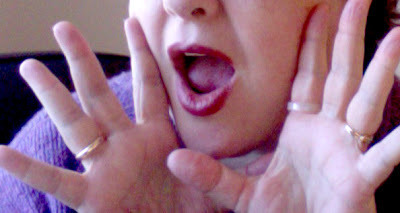
Here's a little example:
Take bites noisily (6)
Now, another word for bites could be CHEWS. And, look, CHOOSE is also another word for take. I think we have a winner! Noisily is the homophone indicator, it's telling you that if you say CHEWS aloud, it will sound like CHOOSE, which is the answer.
One problem with homophone clues is that sometimes it's not clear which of your two options (FOWL vs FOUL) is the correct answer, especially if they have the same number of letters and the indicator is in the middle of the clue! It's hard to be 100% certain sometimes whether the indicator is acting on the first part of the clue, or the last.
In such cases, what you need to do is refer to your partially completed crossword grid, and look for crossing over letters. These should help you nail down the correct answer. In the above example, you'd need to have a checked letter for the third letter in the answer, to tell you if it's FOWL or FOUL.
Homophones are occasionally combined with other clue devices, and can be used to indicate just one letter (eg sounds like tea = T).
Homophone IndicatorsHere is a list of a few homophone indicators. There is a more comprehensive list on my website.
aloudannouncedaudiblycalleddeclaredI hearin auditionlistenon airon the radioorallyoverheardreportedsaidso to speakto the audienceuttervocalvoiced
Practice Homophone Clues
1. Deer is vocal about whipped dessert (6)
2. Sounds like rent is more inflated (6)
3. Told about female deer's money (5)
4. Ferry from California gets arty, on air (4)
5. Labyrinth is made from corn, I hear (4)
Petal and Griff are patiently waiting until you've had a good go at these clues. Scroll past them when you're ready for the explanations and answers!

Explanations
1. Deer is vocal about whipped dessert (6)
One sort of a deer is a MOOSE. Is vocal is the homophone indicator. Whipped dessert is the definition.
2. Sounds like rent is more inflated (6)
To rent something is also to HIRE it. Inflated is the definition. Sounds like is the homophone indicator, naturally!
3. Told about female deer's money (5)
Told about is the homophone indicator here, and money is the definition.
4. Ferry from California gets arty, on air (4)
This is a charade clue that include a homophone. Ferry is the definition (and it's a verb, not a noun!). California = CA, and a homophone (on air) of arty = RT.
5. Labyrinth is made from corn, I hear (4)
What's another word for corn? MAIZE. I hear it, so say it aloud. You'll find the answer very quickly, I'm sure!
Answers
1. MOUSSE
2. HIGHER
3. DOUGH
4. CART
5. MAZE
Homo means 'same', and phone means 'sound' — so homophones are words which sound alike, but have different meanings.
I'm sure you know a ton of these: ATE & EIGHT. FLOUR & FLOWER. FOWL & FOUL. WRIGHT & RIGHT. And that's just for starters!
When a cryptic clue uses a homophone, it tells you that the answer sounds like some other word. The wordplay tells you this. Homophones must have indicator words that give a sense of something being heard, spoken, broadcast, or audible in some way.

Here's a little example:
Take bites noisily (6)
Now, another word for bites could be CHEWS. And, look, CHOOSE is also another word for take. I think we have a winner! Noisily is the homophone indicator, it's telling you that if you say CHEWS aloud, it will sound like CHOOSE, which is the answer.
One problem with homophone clues is that sometimes it's not clear which of your two options (FOWL vs FOUL) is the correct answer, especially if they have the same number of letters and the indicator is in the middle of the clue! It's hard to be 100% certain sometimes whether the indicator is acting on the first part of the clue, or the last.
In such cases, what you need to do is refer to your partially completed crossword grid, and look for crossing over letters. These should help you nail down the correct answer. In the above example, you'd need to have a checked letter for the third letter in the answer, to tell you if it's FOWL or FOUL.
Homophones are occasionally combined with other clue devices, and can be used to indicate just one letter (eg sounds like tea = T).
Homophone IndicatorsHere is a list of a few homophone indicators. There is a more comprehensive list on my website.
aloudannouncedaudiblycalleddeclaredI hearin auditionlistenon airon the radioorallyoverheardreportedsaidso to speakto the audienceuttervocalvoiced
Practice Homophone Clues
1. Deer is vocal about whipped dessert (6)
2. Sounds like rent is more inflated (6)
3. Told about female deer's money (5)
4. Ferry from California gets arty, on air (4)
5. Labyrinth is made from corn, I hear (4)
Petal and Griff are patiently waiting until you've had a good go at these clues. Scroll past them when you're ready for the explanations and answers!

Explanations
1. Deer is vocal about whipped dessert (6)
One sort of a deer is a MOOSE. Is vocal is the homophone indicator. Whipped dessert is the definition.
2. Sounds like rent is more inflated (6)
To rent something is also to HIRE it. Inflated is the definition. Sounds like is the homophone indicator, naturally!
3. Told about female deer's money (5)
Told about is the homophone indicator here, and money is the definition.
4. Ferry from California gets arty, on air (4)
This is a charade clue that include a homophone. Ferry is the definition (and it's a verb, not a noun!). California = CA, and a homophone (on air) of arty = RT.
5. Labyrinth is made from corn, I hear (4)
What's another word for corn? MAIZE. I hear it, so say it aloud. You'll find the answer very quickly, I'm sure!
Answers
1. MOUSSE
2. HIGHER
3. DOUGH
4. CART
5. MAZE
Published on April 16, 2013 20:38
April 14, 2013
Crosswords For Kids
I'm very happy to announce our latest app: Crosswords For Kids! I noticed a while back that all of the crossword apps for children were aimed at the 5 year olds, with pictures of cats and cars and hats as clues. But what about all the kids older than 5 who like word games? Adult crosswords are too hard for them, but those little kiddie crosswords are way too easy.

Enter Crosswords For Kids. I wrote all of the crosswords in this app for kids around 10-13 years old (give or take a few years!). The clues are easier, and the vocabulary is easier. There are clues that mention Adventure Time, My Little Pony, The Simpson, Muppets, Harry Potter, and other 'pop culture' references.I even know adults who are enjoying solving these.
As with our other crossword apps, the interface is completely customisable. You can choose the colours of the background, grid, letters, and highlight. You can choose from five fonts. There are solving aids, too, like having incorrect letters show in red, which is very useful if you're just learning how to solve crosswords!

And yes, we are planning on producing more volumes of these crosswords. One friend's son solved six in one day, so I think I'd better get a wriggle on!

Published on April 14, 2013 19:54
April 10, 2013
Captive Cruciverbalist
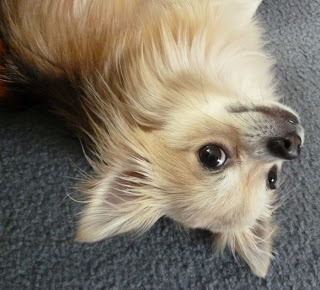
Even Griff is amazed ... yesterday I was called by a lovely ABC radio producer, to ask if I would be the new weekly 'captive cruciverbalist' on Statewide Afternoons with Chris Coleman!
I quickly said yes, and started immediately — you can now hear me on your local ABC radio throughout regional NSW (so not Canberra or Sydney, but everywhere else), on Wednesday afternoons, just after 2:30 pm.
Each week I'll pose one cryptic clue in the session and chat with listeners about their answers, and pose a harder cryptic clue to ponder over the week. The harder clue gets discussed the week after. And so on! I also reveal secrets to solving cryptics, and generally chat about the mad world of crosswords with Chris.
The harder clue is posted on the ABC NSW Facebook Page, and my sessions are available to listen to again on the ABC's blog, too.
Published on April 10, 2013 15:21
April 3, 2013
Gemini 6569

Here we go again, my analysis of the clues in The Canberra Times' Gemini cryptic crossword. This is the one published on Thursday March 28th 2012.
The definitions are underlined (except in double definition and cryptic definition clues).
Across
1. Man of action? (8) = LITIGANT
Cryptic definition. Someone who takes legal action is a LITIGANT.
5. A sticky appointment? (4) = DATE
Double definition, cryptic definition. A DATE can be an appointment, and it's also a sticky fruit.
9. Little girl all round the house (5) = VILLA
Abbreviation + reversal. Little girl = VI (yeah, I know, it could be any two-letter short name for any girl's name! Not that fair.) + LLA (all run round, or backwards).
10. Rushing madly in great confusion (7) = TEARING
Anagram indicated by confusion, the fodder is in great.
11. One in favour of the classics (7,5) = PERSONA GRATA
Cryptic definition. This one was hard! While we're familiar with the term 'persona non grata', this more positive variant is not well known. It means "a person, especially a diplomat, acceptable to certain others; an acceptable person." So they can be said to be one in favour. Of the classics refers to the Latin origin of the phrase.
13. Deter or defer (3,3) = PUT OFF
Double definition. PUT OFF can mean to deter someone, and can also mean to delay or defer an event.
14. Squirm and turn whiter (6) = WRITHE
Anagram, indicated by turn. The word to muddle up is whiter.
17. Maybe a paper is torn making them (12) = PREPARATIONS
I think this is an &lit clue? What do you think? The surface reading as is is a definition of sorts for PREPARATIONS. The 'cryptic' reading of the clue gives us an anagram (indicated by maybe) of a paper is torn. That seems to tick the boxes for an &lit clue. (ETA: not really an &lit, to Des and my minds ... a poor stab at one, anyway.)
20. Beg for an adjustment in net rate (7) = ENTREAT
Anagram of net rate, indicated by an adjustment in.
21. One of the family on the French Riviera we hear (5) = NIECE
Homophone clue, indicated by we hear. NICE is a city on the French Riviera, and it sounds the same as NIECE, who is one of the family.
22. Toy that gives you endless repetition (2-2) = YO-YO
Cute deletion clue. You endless = YOU - U = YO. Then repeat it!
23. Dilatory sort of hero-worship (8) = IDOLATRY
Anagram of dilatory, indicated by sort of.
Down
1. It counts for nothing on the tennis court (4) = LOVE
Cryptic definition. LOVE is the word used to describe a score of nothing in tennis. You may also imagine that on some tennis courts there is no love between the players, LOL.
2. Higher than everyone in the exam? (7) = TALLEST
Container clue. Put everyone (ALL) in another word for the exam (TEST) = T(ALL)EST
3. Lower gas fast making a drink (5,2,5) = GLASS OF WATER
Anagram. The fodder is lower gas fast. The indicator (of sorts) is making. Which to my mind reads more as a linking word than an anagram indicator.
4. Observing the absence of a ring? (6) = NOTING
Charade. Absence = NO + ring (as in the sound, not a piece of jewellery) = TING.
6. Tina comes up with a new name (5) = ANITA
Reversal and charade. Tina comes up = ANIT (Tina written in reverse) with a = A = ANIT+A.
7. In the end the tomb inscription may be (8) = ENGRAVED
Double definition, with a coined meaning. In the tomb could possibly be written as EN-GRAVED (put in a grave). And tomb inscriptions may be ENGRAVED.
8. It cannot be safely ignored (6,6) = DANGER SIGNAL
Cryptic definition. You really need to have some crossing over letters in the crossword grid to get a way in to this one. But it's fair to say that a DANGER SIGNAL cannot be safely ignored.
12. A stroke of the worst misfortune? (8) = APOPLEXY
I think this is a cryptic definition, but admit that I don't have a very satisfactory explanation for the answer, apart from APOPLEXY being a dated definition for a stroke, and having a stroke possibly being the worst misfortune.
15. Most suspenseful points witnessed in the trial (7) = TENSEST
Container. Another use of TEST in a clue (see 2 Down!). In this clue TEST is clued as trial. Points = ENS (or NSE), compass points. They are witnessed in or put inside TEST. T(ENS)EST — or TE(NSE)ST.
16. Left divided (6) = PARTED
Double definition, as very short clues often are. If you left someone, you PARTED from them. And if you PARTED the shrubbery, for example, you divided it.
18. A record number of contestants in the field (5) = ENTRY
Double definition, the first definition is A record, as in a record or ENTRY in a database. The second definition is number of contestants in the field, the singular noun is used to describe the number of competitors in a race.
19. Extremely important part of everything (4) = VERY
Hidden word. An important part of indicates the hidden word. The answer can be found within eVERYthing.
Published on April 03, 2013 16:44
March 30, 2013
Interview: Greg Parker aka The Puzzle Wizard
 The Puzzle Wizard, Greg Parker, and me, Jan 2007.
The Puzzle Wizard, Greg Parker, and me, Jan 2007. The Wizard is standing on a chair.
Greg Parker has been a friend and colleague of mine for many years. He single-handedly produces The Puzzle Wizard series of crossword books, which are available in newsagencies throughout Australia and New Zealand, and on subscription. They are excellent crossword magazines, and some of the few independent crossword publications out there.
I designed Greg's web site, and I also design the covers of his World of Crosswords and Crossword Magic publications. In recent times I have started writing the cryptic in his World of Crosswords mag, too.
I thought you might like to get to know Greg better, so here is my interview for your enjoyment!
Puzzling: How long have you been writing crosswords?
Greg: Since about six years of age — so 43 years.
Puzzling: What got you started on writing them?
Greg: I was fascinated by words (and numbers for that matter) from a young age. Books which featured simple crosswords such as the 'Across and Down' puzzles — crosswords consisting of a 4x4 grid with no black squares where the four across words were the same as the four down words — captured my imagination. Then a book called the Sun Book of Games and Puzzles had a section on how to compile crosswords — and from there I was hooked.
Puzzling: What sort of process do you go through to write your crosswords and
magazines?
Greg: The process is partly automated and partly manual. Any software that I use I've written myself to emulate what I would've done manually anyway. With the crosswords, the grids are designed first, then the words inserted into the grids, then the clues are written. The systems I have to produce the crosswords and magazines have been gradually improved over time. Planning and preparation to produce the crossword magazines started in 1990 — nine years before the first magazine was published.
Puzzling: Are there any subjects that you tend to include or avoid in your
puzzles?
Greg: I try to include subjects which are representative of what Australians take an interest in; this provides plenty of scope for material. There are certain subjects that may offend, and these are avoided or treated cautiously. Disease and sex come to mind. I don't consider religion and politics amongst these, as long as common sense is used of course.
Puzzling: What is the best part of your work?
Greg: Being my own boss is very good. As is working from home, hence avoiding the frustration and loss of time from a daily commute.
Puzzling: What is the most annoying part of your work?
Greg: Two words — Australia Post. They've let me down so many times over the years it isn't funny. If you asked me the hardest part of my work, I'd say the continuous schedule of meeting deadlines.
Puzzling: How do you see The Puzzle Wizard developing over the coming years?
Greg: I have some big plans for The Puzzle Wizard but I'd rather keep them under the wizard's hat for the moment :)
Puzzling: Do you play any word games to relax, or have you had enough of them
by the end of the day? What do you like to do to relax?
Greg: I tend to avoid word games when I'm not working and just try to give the mind a break, as producing the books can get pretty intense in a mental sense. To relax I have coffee with my wife, watch AFL and AFL discussion shows.
Puzzling: So you're keen on AFL are you?
Greg: Yes - I've followed Morningside in the local comp for as long as I've been making crosswords.
Puzzling: What's something most of your readers wouldn't know about you?
Greg: Like Laurie Lawrence and the new pope, I have only one lung.
Thank you Greg!
Published on March 30, 2013 23:58
March 26, 2013
Blankity blanks
Wiley produced two editions of Solving Cryptic Crosswords For Dummies. A paper book, and an eBook. The big downside of an eBook crossword book, however, is that (so far) you can't solve the crosswords on your eBook reader!
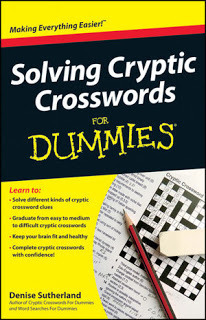
To counteract this failing, I put together all the blank crossword grids from the book (sans clues — you need the book for them!). Wiley have 'Dummified' the layout, and put them up online. So, if you have the eBook edition (or want to tackle the crosswords in your paper book a second time), download the free PDF, print the grids out, and solve to your heart's content!
Published on March 26, 2013 16:22
March 19, 2013
ANZSI Conference
My apologies for being rather invisible for a while, I've had two overseas trips in the past month! Anyway, I'm back again, and will try to heed my daughter's command to "Stay, Mummy, STAY!" for the rest of the year (although New York is beckoning).
Last week I attended my first indexing conference, the biennial conference of the Australian and New Zealand Society of Indexers (ANZSI). Wow, that sounds so exciting, I hear you mutter sarcastically.
Well, let me tell you, it was awesome. I met so many fabulous, intelligent, funny, and generous people (there were around 80 of us at the conference), learnt so many interesting things, found out how to expand my indexing business and improve my skills — and all in the delightful environs of Wellington, New Zealand.
Wellington is similar to Canberra — the national capital that no-one is aware of. No, Sydney's not the capital of Australia, my hometown Canberra is. And Auckland isn't capital of New Zealand, it's Wellington. About the same population too (~400,000), with spectacular scenery.
These are some of the views from our conference venue, out across the Wellington Harbour.
 View to the Wellington Harbour
View to the Wellington Harbour Customhouse Quay from above
Customhouse Quay from above
 Customhouse Quay street view
Customhouse Quay street view
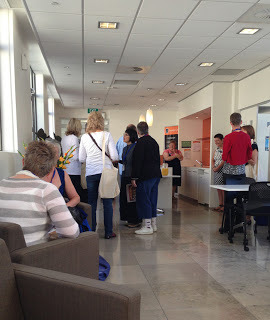 An early morning gathering of indexers, in the nomming areaWellington is a delightful city, one might even risk calling it quaint. It's much older than Canberra, established in 1839. There are a lot of beautiful wooden buildings. If it wasn't for the risk of earthquakes, which is a bit too worrying for me, I would happily live here.
An early morning gathering of indexers, in the nomming areaWellington is a delightful city, one might even risk calling it quaint. It's much older than Canberra, established in 1839. There are a lot of beautiful wooden buildings. If it wasn't for the risk of earthquakes, which is a bit too worrying for me, I would happily live here.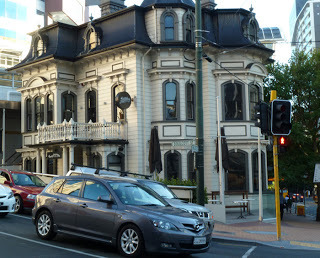 The General Practitioner pub, Willis St, WellingtonSo, what on earth are indexers, and what do they talk about at a whole three day conference?
The General Practitioner pub, Willis St, WellingtonSo, what on earth are indexers, and what do they talk about at a whole three day conference?Indexers are the redoubtable souls who create the indexes at the back of non-fiction books. They also index things like journals, magazines, collections of papers, annual reports, and so on. A good index is the main 'finding aid' for a book, a way to find your way around the content. It is a creative and skilled art. The indexer gets the manuscript close to the end of the whole publication process (so always on a tight deadline), reads through the whole thing, and writes the index as they go. The index requires a lot of editing and structure work to get it working well. There are a bunch of conventions to remember to follow, too. We work with authors, editors, and publishers.
A big issue in the indexing world at the moment is how eBooks can still retain working indexes, especially as eBooks don't always have page numbers. The text flows around, depending on the reading device's screen size, and the reader's settings (bigger font, smaller font, typeface etc). No fixed page numbers to link index entries to!
It is possible to create a 'clickable' interactive index, but most eBook publishers, when converting a paper book to an eBook, simply delete the index, or leave it in, but without any interactivity or way of finding the content. A search function doesn't cut it — it throws up every single occurrence of a particular word, and can't tell you which are the locations with the best quality information. So a lot of our discussions focussed on the world of eBooks and the EPUB book standard. Basically, the tools to help us do this task easily just haven't been developed, so this is very much bleeding edge stuff. We can create these interactive indexes, but it's not easy (yet).
The intrepid American indexer Jan Wright and my delightful Aussie indexing teacher Glenda Browne gave a great presentation about EPUBs and different ways of creating interactive eBook indexes in a range of file formats and outputs. Their talk was entitled The Matrix, so naturally, they both dressed up as Trinity. It had to be done. American programmer David K. Ream gave several presentations on EPUB and eBook indexing. I attended Jan's workshop about embedded and hyperlinked indexing using Adobe InDesign.
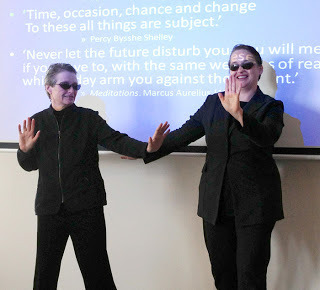 Jan Wright (L) and Glenda Browne (R) cleverly disguised as Trinity
Jan Wright (L) and Glenda Browne (R) cleverly disguised as TrinityA Japanese academic indexer also attended, and astonished us all with stories about how Japanese indexes are written : entirely by hand. The indexer works through the book, writes their entries into a sheet such as this one, then cuts up the strips, and puts them in order by hand. They have bags of strips for a single book, and the process takes months if not years. This was rather flabbergasting to us spoilt non-Asian indexers who use indexing software to help us create and organise our work.
 A Japanese index worksheet
A Japanese index worksheetI attended a session on using Regex (Regular Expressions, not grep — thank you David for the clarification) in Cindex (the indexing software I use), run by the elegant and lovely Frances Lennie, who is one of the founders and owners of Cindex. I also attended workshops on typesetting dilemmas in indexes, setting up an indexing business, how you deal with numerical entries in an index, and working with editors and publishers, amongst others.
 View from Mt Victoria across the Wellington Harbour
View from Mt Victoria across the Wellington Harbour
 View from Mt Victoria to WellingtonApart from all these interesting sessions, I loved meeting so many indexers in one place! They are really splendid people. I especially enjoyed meeting the Americans Jan Wright, Pilar Wyman, David K. Ream, and Kay Schlembach, as well as many New Zealand indexers, and meeting up again with my Aussie colleagues.
View from Mt Victoria to WellingtonApart from all these interesting sessions, I loved meeting so many indexers in one place! They are really splendid people. I especially enjoyed meeting the Americans Jan Wright, Pilar Wyman, David K. Ream, and Kay Schlembach, as well as many New Zealand indexers, and meeting up again with my Aussie colleagues.We had a brilliant conference dinner at the Roxy Cinema, delicious meal, with unexpected and hilarious entertainment by The Improvisers. Jan and I were called up to participate too – we had to 'work' the actors as puppets, making them move while they told a story about Vivacious Denise and Intrepid Jan. Nearly died laughing.
The New Zealand branch did a fabulous job organising the conference – they'll be a hard act to follow (and I'm on the organising committee of the next one, Canberra 2015!). It was hard to say good bye to so many friends, both new and old, but I'm sure our paths will cross again!
 Jan Wright (L) and me - an intrepidly vivacious pair!All too soon, the conference was over. I had Saturday free to look around Wellington a little more. I naturally gravitated to the nearest wool shop, Knit World, and bought some merino possum yarn (Aussie possums are an out-of-control introduced pest in NZ, so hunting is permitted, and their fur is turned into a very soft yarn).
Jan Wright (L) and me - an intrepidly vivacious pair!All too soon, the conference was over. I had Saturday free to look around Wellington a little more. I naturally gravitated to the nearest wool shop, Knit World, and bought some merino possum yarn (Aussie possums are an out-of-control introduced pest in NZ, so hunting is permitted, and their fur is turned into a very soft yarn).
The Satay Kingdom Café was a little hole-in-the-wall place just down from the yarn shop. Sitting outside on a warm sunny day, eating Malaysian Roti Chanai with Curry Chicken Soup was perfect.

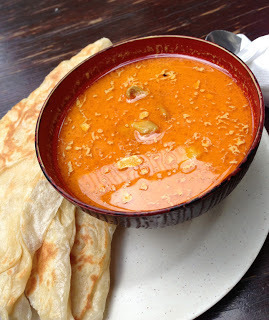
My friend Jane and I were sharing an apartment room, and were amused by this local yoghurt we bought for breakfast : Mammoth Yoghurt for men. It was heartily delicious, but I was a bit alarmed that after eating it, I suddenly became very interested in all the nice men's fashion and shoe shops around Wellington, and had a hankering for aftershave. It must have been a bit too strong for me!

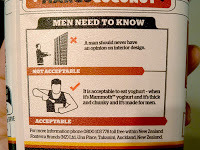
I visited Ninjaflower a few times, as it was only a few doors down from our hotel. I bought two pairs of gorgeous spiral earrings, one black horn pair, and one in shell.
Wellington is famous, of course, as the home of the Weta Workshop, and the locale for many scenes in the Lord of the Rings movies. On our half day off, we went for a bus tour around some of the locations — Helm's Deep and Rivendell mainly. It was amazing how there was nothing left of the movie sets, you could only tell from various signs around the place. The scenery was stunning, very green and majestic.
We also went to the Weta Workshop. The visit was a bit of a disappointment, as you can't actually go in and see the workshops at all (all hush hush), and the gift shop was very small with very expensive merchandise. There was a filmed 'tour' for visitors, which was interesting, though.
 The quarry that was once Helm's Deep
The quarry that was once Helm's Deep A Rivendell scene
A Rivendell scene
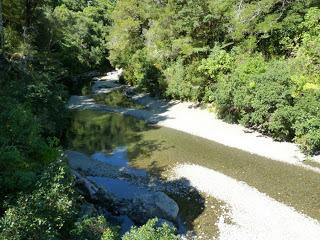
River ford, Kaitoke Regional Park, Upper Hutt
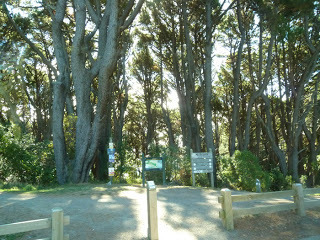 Mt Victoria, where the 'hobbits hiding from the
Mt Victoria, where the 'hobbits hiding from the Nazgul under the tree roots' scene was filmed
 Gollum at the Weta Cave shop
Gollum at the Weta Cave shop

On our last day in Wellington, Jane and I went to the Museum of New Zealand, Te Papa. The giant squid was one of my favourite exhibits ... I was just relieved that it was safely behind a very thick glass (and dead ... but you can never be too careful when it comes to giant squids!).
Published on March 19, 2013 23:00



